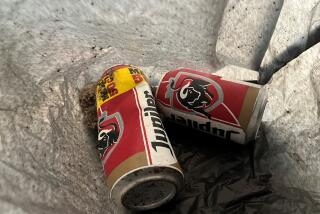Rembrandt smiles on Getty Museum visitors and staff
The riches and fame he would earn as the greatest painter of the Dutch Golden Age were still to come. Many years ahead lay the death of his beloved wife and three of their four children, along with bankruptcy and near financial ruin.
But in 1628, or thereabouts, a robust and ambitious Rembrandt Harmensz van Rijn, then 21 or 22, threw back his head and laughed, then captured the moment in an oil painting on a copper plate about the size of an iPad.
On Tuesday morning, concluding a brief legal standoff with Britain’s cultural guardians, that lighthearted portrait of the artist landed on a wall of the East Pavilion of the Getty Museum, eliciting grins from a cluster of Getty staffers and appreciative murmurs from a handful of early visitors.
CRITICS’ PICKS: What to watch, where to go, what to eat
“Of all these self-representations — I think there are over 80 in his lifetime in different media — there are only really two in which he’s smiling,” said Anne Woollett, a Getty curator of painting and a specialist on Dutch and Flemish painting. “He wanted to be seen as a serious fellow.”
Dubbed “Rembrandt Laughing,” the painting was acquired by the Getty last May for an estimated $25.1 million. Long classified as missing by experts, it had stunned the art world when it surfaced in a 2007 country auction in Gloucestershire in England.
But soon after the Getty bought the work from a dealer, its export license was frozen by British cultural authorities, invoking a law that allows for the foreign purchase of an artwork more than 50 years old to be vetoed if it is deemed of cultural “special significance” and a British institution steps forward to match or exceed the purchase price.
ART: Can you guess the high price?
Fortunately for the Getty, Britain already has a substantial stock of exceptional Rembrandts, though relatively few early ones. “Rembrandt Laughing,” the Getty’s fifth work by the artist, hangs between two other Rembrandt paintings, “An Old Man in Military Costume” (1630-31) and “The Abduction of Europa” (1632).
“Rembrandt Laughing” dates from the artist’s early adulthood in his native Leiden, a few years before he moved to Amsterdam. Rendered in quick, assured brushstrokes, it shows him ruddy-cheeked with shoulder-length hair, wearing a dark purple and brown outfit and a gleaming steel gorget, against a feature-less gray background.
The work bears a monogram in the upper left corner, and scholarly research has revealed the ghost of an underpainting.
PHOTOS: Arts and culture in pictures by The Times
Technically, Woollett said, the painting is not a self-portrait, but a tronie (named after the Dutch 17th century word for a face). Typically in these works the sitter’s face bears an exaggerated, theatrical expression. Sometimes the subject is outfitted in costume, like a stock character — in this case, a soldier.
“He’s using his own features because he’s interested in the study of expression and emotion,” Woollett said. “It’s a character study, so it’s as much about a laughing soldier as it is a representation of him.”
“He’s really showing us this sense of being.”
For many years, the painting had been mis-attributed to a “follower of Rembrandt” and, later, to Frans Hals.
CHEAT SHEET: Fall arts preview
Scott Schaefer, senior curator of paintings at the Getty Museum, said that, basing his initial judgment on poor reproductions, he previously had thought the work might’ve been by one of Rembrandt’s pupils, Gerrit Dou.
But when he came face to face with the original painting, Schaefer had no doubt who its author was.
“There is a sense of just sheer technical ability, coupled with the sense of joie de vivre that you don’t get in something like Dou, who’s a wonderful artist,” Schaefer said. He compared the impact of the painting to seeing Greta Garbo laugh in “Ninotchka,” her first screen comedy.
“It’s disarming for that reason, because we’re not used to seeing him happy,” he said.
More to Read
The biggest entertainment stories
Get our big stories about Hollywood, film, television, music, arts, culture and more right in your inbox as soon as they publish.
You may occasionally receive promotional content from the Los Angeles Times.











